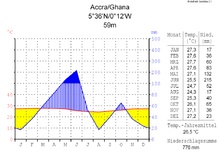Dahomey Gap
The Dahomey Gap (also Dahomey Corridor ) is a dry zone on the Guinea coast of West Africa, which stretches from southeast Togo and central Benin to western Nigeria . It connects to a coastal dry zone in the area of Ghana and Togos (Ghana Dry Zone) and forms an almost forest-free savanna corridor, which is embedded between evergreen tropical rainforests to the west and east of it (the English word "gap" means "gap") , Dahomey is the former name of Benin). The rainforests west of the corridor are known as the Upper Guinean Forests , and those east of it are called the Lower Guinean Forests .
Climate and causes of drought
Accra , located in the adjoining dry zone of Ghana, receives an average annual precipitation of less than 800 mm (although, like the Dahomey Gap to the northeast, it belongs to the area of influence of the West African monsoons ), about twice that would be required for a tropical rainforest at this geographical latitude. Even the precipitation in the Dahomey Gap (around 1100 to 1200 mm) is not enough because of the high evaporation .
A complex interplay of oceanographic and atmospheric factors work together to create this dry zone . In August the sea surface temperatures in parts of the northern Guinea Gulf drop from over 28 ° C to 21.5 ° C. Swelling cold deep water stabilizes the lower troposphere and thus reduces the amount of precipitation. This also has a corresponding effect on the energy of thunderstorm lines migrating inland. The prevailing south-westerly monsoonal wind direction is partly responsible for the appearance of the cold deep water on the sea surface. However, a cold Kelvin wave that occurs in the equatorial Atlantic and hits the shelf in front of the dry region plays a special role . The orography also has a certain influence : The Atakora mountain range , which reaches almost 1000 m, combs part of the moisture from the monsoon winds. The development of the high-altitude wind field in the area of the Dahomey Gap also promotes less convection here than in the adjacent humid zones.
History and meaning
As pollen analyzes have shown, the Dahomey Gap has only existed in its current (vegetation) form for around 4000 years. In earlier phases of the Holocene , especially during the interglacial periods , the precipitation was temporarily sufficient to close the gap through forest. The aisle (savanna or a forest-savanna mosaic, rich in oil palms , among other things ) now acts as a natural barrier for the exchange of species of animals and plants between the forest areas to the west and east of it.
Anthropogenic causes are not responsible for the formation of the corridor. However, its relative drought makes the region particularly susceptible to human disturbance in terms of water supply. Some crops of the subhumid tropics are here under the aspect of precipitation at their lower cultivation limit.
literature
- Patrick Vollmert, Andreas H. Finck, Helga Besler: Ghana Dry Zone and Dahomey Gap: Causes of a precipitation anomaly in tropical West Africa . Earth 134 (4), 375-393 (2003) (PDF file; 5.66 MB)
- Ulrich Salzmann: The Dahomey Gap: an abrupt climatically induced rain forest fragmentation in West Africa during the late Holocene . The Holocene 15 (2): 190-199 (2005).
